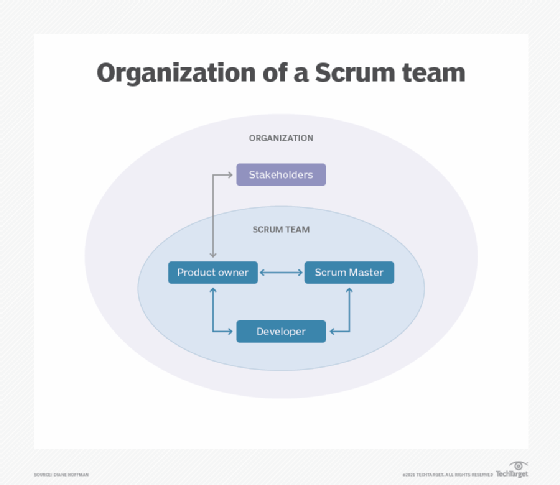What is a product owner?
A product owner is a role on a Scrum team that is responsible for the project's outcome. The product owner seeks to maximize a product's value by managing and optimizing the product backlog.
Scrum is an Agile software development framework that enables a team to communicate and self-organize. Scrum enables participants to act quickly and in accordance with Agile principles when implemented effectively.
Product owner roles and responsibilities
In Scrum, a product owner serves as the liaison between multiple areas of an organization. This person communicates with business stakeholders and collaborates closely with Scrum teams to keep all areas of the business informed on a project's development.

A product owner works with stakeholders and end users -- commonly through techniques such as early user interaction studies and A/B testing -- to visualize the project's ultimate direction. Product owners are responsible for understanding all these types of feedback because those details explain how users interact with the product and which functions users consider to be most important. The product owner compares that information with the business goals, then endeavors to maximize the product's value.
The product owner develops a vision of a product's function and operation, which allows them to define product features and break those features into product backlog items.
In short, a product owner's responsibilities are the following:
- Develop the product features and goals.
- Create product backlog items based on product goals.
- Order product backlog items, ensuring that the product backlog is visible and understood.
- Serve as the liaison between business stakeholders, Scrum team members and end users.
In addition to these roles, the product owner reports project progress to someone further up in the business hierarchy. In many organizations, the product owner reports to the director of product management. With this line of communication, the product owner can update management while keeping the development team on track.
How a product owner interacts with the Scrum team
A product owner interacts with the Scrum team weekly, if not daily. The product owner might participate in the daily Scrum to hear firsthand about progress and problems. Most importantly, about once a week, the product owner meets with the Scrum team to work on backlog refinement and prepare the backlog items for the upcoming Scrum. Another important meeting for the product owner is the sprint review, where they summarize the progress of completed sprints to business stakeholders.
In many organizations, the product owner is responsible for multiple projects, which means they work with multiple teams. It's important that the product owner carefully balances their time and attendance. They can't participate in every element of each group's development process or attend all meetings. Product owners need to pay attention to various groups, including stakeholders, end users and the Scrum teams. When the product owner can't be in a meeting, they can follow the Scrum framework and delegate these responsibilities to others.
Skills and certifications a product owner needs
Product owners should possess skills in listening, critical thinking, decision-making and leadership. They should be able to empower the Scrum team and engage developers on how to best solve problems.
Scrum.org and the Scrum Alliance are reputable organizations that offer certification for product owners. A product owner certification can be especially valuable to someone who is stepping into this role for the first time or transitioning into the Scrum product owner role from other software development models.
Why does a Scrum team need a product owner?
Every Scrum team needs a defined vision for its product. It's the product owner's responsibility to craft a strategy, define features and ensure that backlog items are created. The product owner also prioritizes the backlog to non-Scrum team members. In the Scrum framework, these responsibilities fall under the product owner umbrella.
If a Scrum team doesn't have a product owner, the door is opened for misguided priorities -- for example, taking directions from stakeholders, who don't always think the same way as the Scrum team. Without a product owner, the team won't follow the proper guidelines and workflow for product development. This can lead to significant problems.
How a product owner differs from a Scrum Master or project manager
Scrum Masters and product owners both have responsibilities related to the management and optimization of the product backlog. The two roles should work together to determine what work is necessary to deliver a successful product.
However, a product owner must be attentive to both customers and the people working on the software. This reality is most visible in their work to define features and prioritize development but also in their responsibility for a product's vision. A Scrum Master focuses on how to prepare for and successfully execute sprints along with how to refine processes to support team performance.
Similarly, a product owner and a project manager are both accountable for project outcomes. However, while the product owner focuses on creating a product that meets the needs of stakeholders and end users, the project manager is concerned with delivery commitments and effective resource utilization.



